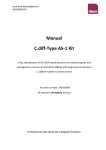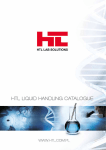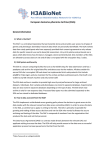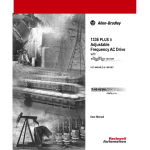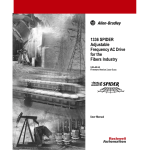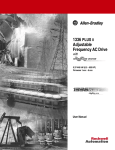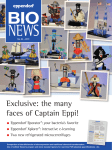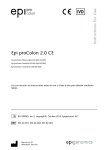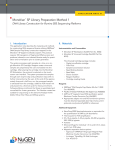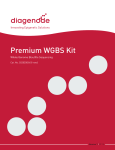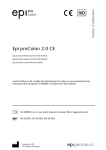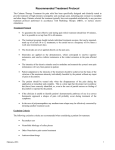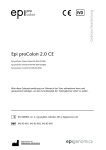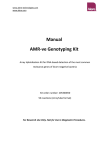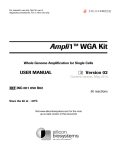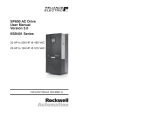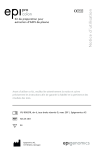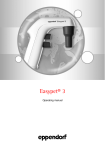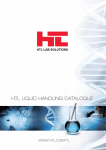Download f - Epi proColon
Transcript
Epi proColon 2.0 CE Epi proColon Plasma Quick Kit (M5-02-001) (M5 Epi proColon Sensitive PCR Kit (M5-02-002) (M5 Epi proColon Control Kit (M5-02 02-003) The instructions for use must be read carefully prior to use and followed precisely to achieve reliable results. IFU 0009GB, rev 5,, copyright©, copyright September 2014,, Epigenomics AG M5-02-001, M5-02-002, 002, M5-02-003 M5 Epigenomics AG, 10829 Berlin, Germany Instructions For Use Contents 1. Name and Intended Use ................................................................................................................................3 2. Summary and Explanation .............................................................................................................................3 3. Principles of the Procedure ............................................................................................................................3 4. Materials Provided..........................................................................................................................................4 4.1. Contents ................................................................................................................................................... 4 4.2. Safety Information ..................................................................................................................................... 4 5. Storage and Stability ......................................................................................................................................5 5.1. Epi proColon Plasma Quick Kit (M5-02-001) .............................................................................................. 5 5.2. Epi proColon Sensitive PCR Kit (M5-02-002) .............................................................................................. 5 5.3. Epi proColon Control Kit (M5-02-003) ....................................................................................................... 6 6. Materials Required, but not Provided ...........................................................................................................6 6.1. General Laboratory Equipment .................................................................................................................. 6 6.2. General Laboratory Consumables and Reagents ......................................................................................... 6 6.3. Required Special Equipment and Consumables........................................................................................... 7 6.4. Installation Requirements........................................................................................................................... 7 7. Warnings and Precautions .............................................................................................................................8 7.1. Laboratory Precautions .............................................................................................................................. 8 7.2. Microbiological and Infectious State........................................................................................................... 8 8. Sample Collection and Handling ...................................................................................................................8 8.1. Blood Collection and Blood Storage ........................................................................................................... 8 8.2. Plasma Sample Preparation and Plasma Storage ......................................................................................... 8 9. Test Procedure ................................................................................................................................................9 9.1. Preparation of Working Solutions ............................................................................................................... 9 9.2. DNA Extraction and Bisulfite Conversion from Patient Plasma ..................................................................... 9 9.3. PCR Setup ............................................................................................................................................... 13 10. Analysis with the Applied Biosystems 7500 Fast and 7500 Fast Dx PCR Instruments..............................14 10.1. Software Requirement ............................................................................................................................. 14 10.2. PCR Plate Preparation (Applied Biosystems 7500 Fast and 7500 Fast Dx)................................................... 14 10.3. Plate Loading (Applied Biosystems 7500 Fast and 7500 Fast Dx) ............................................................... 15 10.4. Analysis Settings (Applied Biosystems 7500 and 7500 Fast Dx) ................................................................. 18 10.5. Run Validity by the Epi proColon Controls ................................................................................................ 19 10.6. Interpretation of Results for a Single PCR ................................................................................................. 19 11. Analysis with Roche LightCycler 480 Instrument I .....................................................................................20 11.1. Plate Preparation (LightCycler 480 Instrument I)....................................................................................... 20 11.2. Plate Loading (LightCycler 480 Instrument I)............................................................................................ 20 11.3. Analysis Settings (LightCycler 480 Instrument I) ....................................................................................... 20 11.4. Run Validity by the Epi proColon Controls (LightCycler 480 Instrument I) ................................................. 21 11.5. Interpretation of Results for a Single PCR (LightCycler 480 Instrument I) ................................................... 22 12. Analysis with the Roche LightCycler 480 Instrument II .............................................................................23 12.1. Plate Preparation (LightCycler 480 Instrument II)...................................................................................... 23 12.2. Plate Loading (LightCycler 480 Instrument II) ........................................................................................... 23 12.3. Analysis Settings (LightCycler 480 Instrument II) ...................................................................................... 23 12.4. Run Validity of the Epi proColon Test Result (LightCycler 480 Instrument II) .............................................. 25 12.5. Interpretation of Results for a Single PCR (LightCycler 480 Instrument II) .................................................. 25 13. Interpretation of Results for a Patient Sample ...........................................................................................26 14. Quality Control .............................................................................................................................................26 14.1. External Controls ..................................................................................................................................... 26 14.2. Internal Controls ..................................................................................................................................... 26 15. Limitations of the Procedure .......................................................................................................................27 16. Performance Characteristics ........................................................................................................................27 16.1. Analytical Sensitivity ................................................................................................................................ 27 16.2. Reproducibility ........................................................................................................................................ 27 16.3. Clinical Sensitivity and Specificity ............................................................................................................. 27 16.4. Concordance of the Two Real-Time PCR instruments ................................................................................ 28 16.5. Interference ............................................................................................................................................. 28 17. Meaning of Symbols .....................................................................................................................................29 18. References .....................................................................................................................................................29 19. Contact Information .....................................................................................................................................30 Page 2 of 30 Instructions For Use 1. Name and Intended Use Epi proColon 2.0 CE is a qualitative assay for the real-time PCR detection of methylated Septin9 DNA in bisulfite converted DNA from human plasma samples. Presence of methylated Septin9 is associated with, and may aid in, the detection of colorectal cancer. Epi proColon 2.0 CE is comprised of the Epi proColon Plasma Quick Kit (M5-02-001), the Epi proColon Sensitive PCR Kit (M5-02-002) and the Epi proColon Control Kit (M5-02-003). 2. Summary and Explanation Epi proColon 2.0 CE is an in vitro polymerase chain reaction (PCR) assay for the qualitative detection of Septin9 gene methylation in DNA isolated from 3.5 ml of patient plasma. Cytosine residues in the v2 region of the Septin9 gene become methylated in colorectal cancer (CRC) tissue but not in normal colon mucosa. This aberrant methylation can be detected by specific amplification of DNA present in the blood stream. Detection of CRC DNA in plasma using the Septin9 methylation biomarker has been demonstrated in multiple case control studies of CRC patients and colonoscopy-verified negative controls1-3. The blood-based Epi proColon 2.0 CE offers patients, who currently refuse screening colonoscopy, a reasonable alternative to non-invasive CRC screening options. 3. Principles of the Procedure Epi proColon 2.0 CE involves two steps. In the first step DNA is extracted from plasma followed by bisulfite conversion of the purified DNA using the Epi proColon Plasma Quick Kit (M5-02-001). In the second step bisulfite converted DNA (bisDNA) is assayed in a duplex PCR using the Epi proColon Sensitive PCR Kit (M5-02-002) which detects both the target methylated Septin9 DNA and an internal control, ACTB (ß-actin) DNA, to assess adequacy of input DNA. Controls provided with the Epi proColon Control Kit (M5-02-003) are required as positive and negative controls for each run. The extraction of DNA contained in patient plasma is based on the binding of free-circulating DNA to magnetic particles, which are then magnetically separated from the plasma. Remaining impurities are removed from the magnetic particles during the washing steps. In the elution step purified DNA is removed from the magnetic particles by dissolving in elution buffer. The eluate containing DNA is then subjected to a chemical reaction that specifically alters unmethylated cytosine residues within the DNA. Bisulfite treatment is utilized as the method of choice for analyzing DNA methylation. The conversion is based on the nucleophilic addition of a bisulfite ion to a cytosine nucleotide and a subsequent deamination reaction to yield uracil sulfonate, while 5-methylcytosine (methylated cytosine) does not undergo the deamination reaction and remains unchanged. The blockers and probes used in the subsequent PCR reaction discriminate between methylated and unmethylated sequences. Epi proColon 2.0 CE detects a bisDNA sequence containing methylated CpG sites within the v2 region of the Septin9 gene and total bisDNA of a region of the ACTB gene. The Septin9 portion of the duplex assay consists of primers that are placed in regions lacking CpG dinucleotides. A blocker specific for bisulfite converted unmethylated sequences within the region is added so that methylated sequences are preferentially amplified. A methylated Septin9-specific fluorescent detection probe is used in the reaction in order to exclusively identify methylated sequences amplified during the PCR reaction4. Page 3 of 30 Instructions For Use 4. Materials Provided 4.1. Contents Colon Plasma Quick Kit. Kit Table 1: Contents of the Epi proColon Containers Volume Storage Temperature Epi proColon Colon Lysis Binding Buffer 1 bottle 125 ml 15° C to 30° C Epi proColon Colon Wash A Concentrate 1 bottle 60 ml 15° C to 30° C Epi proColon Magnetic Beads 1 bottle 4 ml 15° C to 30° C Epi proColon Colon Wash B Concentrate 1 bottle 7 ml 15° C to 30° C Epi proColon Elution Buffer 1 tube 6 ml 15° C to 30° C Epi proColon Bisulfite Solution 4 tubes 1.9 ml each 15° C to 30° C Epi proColon Protection Buffer 1 tube 1 ml 15° C to 30° C Containers Volume Storage Temperature Epi proColon PCR Mix 2 tubes 810 µl each --25° C to -15° C Epi proColon Polymerase 1 tube 85 µl --25° C to -15° C Containers Volume Storage Temperature Epi proColon Negative Control 6 tubes 3.65 ml each --25° C to -15° C Epi proColon Positive Control 6 tubes 3.65 ml each --25° C to -15° C Reagent Colon Sensitive PCR Kit. Kit Table 2: Contents of the Epi proColon Reagent Colon Control Kit. Kit Table 3: Contents of the Epi proColon Reagent 4.2. Safety Information When working with chemicals, always wear a laboratory coat and disposable gloves. Clean contaminated surfaces with water. water. For more information, please consult the respective material safety data sheets (MSDS) available on our webpage (http://www.epiprocolon.com/en/laboratories/septin9 http://www.epiprocolon.com/en/laboratories/septin9test/safety-data-sheets.html). Colon Lysis Binding Buffer and Epi proColon Wash A Epi proColon Concentrate: contain TRITON X-100 X and Guanidinium thiocyanate Hazard statements: EUH032: Contact with acids liberates very toxic gas; H302: Harmful if swallowed; H312: Harmful in contact with skin; H318: Causes serious eye damage; H332: Harmful if inhaled; H412: Harmful to aquatic life with long lasting effects. Precautionary statements: P261: Avoid breathing aerosols; P273: Avoid release to the environment; P301 + P312: IF SWALLOWED: Call a POISON CENTER or doctor/physician if you feel unwell; P302 + P352: IF ON SKIN: Wash with plenty of soap and water; P305 + P351 + P338: IF IN EYES: Rinse cautiously with water for several minutes. Remove contact lenses, if present and easy to do. Continue rinsing. DANGER ANGER Page 4 of 30 Instructions For Use Epi proColon Colon Bisulfite Solution: contains aqueous solution of Ammonium bisulfite (Ammonium Ammonium hydrogen sulfite) Hazard statements: EUH031: Contact with acids liberates toxic gas; H314: Causes severe skin burns and eye damage. Precautionary statements: P264: Wash hands thoroughly after handling; P271: Use only outdoors or in well-ventilated well areas; P280: Wear protective gloves/protective clothing; P305+351+338: IF IN EYES: Rinse cautiously with water for several minutes. Remove contact lenses, if present and easy ea to do. Continue rinsing; P312: Call a POISON CENTER or doctor/physician if you feel unwell. DANGER Epi proColon Colon Protection Buffer: contains 6-hydroxy-2,5,7,8tetramethylchromane-2-carboxylic carboxylic acid, acid Tetrahydrofurfurylalcohol Hazard statements: H319: Causes serious eye irritation. Precautionary statements: P305 + P351 + P338: IF IN EYES: Rinse cautiously with water for several minutes. Remove contact lenses, if present and easy to do. Continue rinsing. rinsing WARNING Epi proColon Colon Wash B Concentrate, Epi proColon Elution Buffer, Epi proColon Colon Magnetic Beads, Epi proColon PCR Mix, Epi proColon pro Polymerase, Epi proColon Positive Control, and Epi proColon Negative Control are not harmful. harmfu 5. Storage and Stability pro Plasma Quick Kit (M5-02-001), Epi proColon Colon Sensitive PCR Kit Reagents provided with the Epi proColon (M5-02-002) and Epi proColon Colon Control Kit (M5-02-003) (M5 003) are stable until the expiration date when stored and handled as directed. Do not use material past expiration date. Do not mix component components from different kit lots. 5.1. Epi proColon Colon Plasma Quick Kit (M5-02-001) (M5 Store all reagents of the Epi proColon Colon Plasma Quick Kit at 15 to 30 °C. Epi proColon Colon Bisulfite Solution is sensitive to oxygen contact. Use only unopened tubes of Epi proColon Colon Bisulfite Solution. Discard used tubes! Store reconstituted Epi proColon Wash A Buffer and reconstituted Epi proColon Wash B Buffer at 15 to 30 °C for up to 6 weeks. After first use store all reagents at 15 to 30 °C for up to 6 weeks. 5.2. Epi proColon Colon Sensitive PCR Kit (M5-02-002) Colon Polymerase at Store Epi proColon PCR Mix and Epi proColon -25 to -15 °C. Each Epi proColon PCR Mix tube may be thawed and refrozen one time. After first use store all reagents at -25 25 to -15 °C for up to 6 weeks. Page 5 of 30 Instructions For Use 5.3. Epi proColon Control Kit (M5-02-003) Store Epi proColon Control Kit at -25 to -15 °C. 6. Materials required, but not Provided 6.1. General Laboratory Equipment The following general laboratory equipment is required to perform the Epi proColon 2.0 CE test. All laboratory equipment must be installed, calibrated, operated, and maintained according to the manufacturer’s recommendations. Required Equipment Suggested Equipment Tube rack for 15 ml tubes and 2 ml tubes VWR International, catalog no. 211-0200, or equivalent Rotator VWR International, catalog no. 445-2102; Carl Roth GmbH + Co. KG, catalog no. Y549.1, or equivalent Vortex VWR International, catalog no 444-1372, or equivalent Thermoshaker for 2 ml tubes ThermoMixer® C, Eppendorf, catalog no. 5382 000.015, with dry heating block 2 ml, Eppendorf, catalog no. 5362 000.035, or equivalent Pipettes with adjustable volumes of the following ranges 10 - 100 µl, 100 - 1000 µl Eppendorf Reference®, adjustable volume pipette, Eppendorf, catalog no. 4910 000.042 and 4910 000.069, or equivalent Repeat pipettor capable of repetitively dispensing volumes in an adjustable range Eppendorf Multipette® M4, Eppendorf, catalog no. 4982 000.012, or HandyStep® electronic, Brand, catalog no. 705000/705001, or equivalent Bench top centrifuge with rotor for 1.5/2.0 ml tubes Centrifuge 5418, Eppendorf, catalog no. 5418 000.017with rotor F-4530-11, Eppendorf, catalog no. 5490 015.002, or equivalent Multichannel pipette Eppendorf Research® plus 8-Channel, 10 - 100 µl, Eppendorf, catalog no. 3122 000.035, or equivalent Plate centrifuge capable for PCR plates Centrifuge 5804 R, Eppendorf, catalog no. 5804 000.013, with rotor A-2DWP, Eppendorf, catalog no. 5804 740.009, or equivalent 100 ml graduated cylinder or 50 ml serological pipette Carl Roth, catalog no. C177.2, or equivalent, or Fisher Scientific, catalog no. 11889181, or equivalent 6.2. General Laboratory Consumables and Reagents Consumables and Reagents Suggested Consumables and Reagents Ethanol absolute (for molecular biology, ≥99.5 %) Merck KGaA, catalog no. 1.08543.0250, or equivalent 15 ml polypropylene centrifuge tubes with conical bottom, PP/sterile Sarstedt, catalog no. 62.554.502, or equivalent 2.0 ml microtubes with round bottom and with attached PP cap with lid seal mechanism Sarstedt SafeSeal, catalog no. 72.695.400 or Eppendorf Safe-LockTM, catalog no. 0030 120.094, or equivalent Pipette tips with aerosol barrier ep Dualfilter T.I.P.S.®, Eppendorf: § 2 – 100 µl, catalog no. 0030 077.547, or equivalent § 50 – 1000 µl, catalog no. 0030 077.571, or equivalent Tips for repetitive pipettes for volumes of 0.5 ml, 1 ml, 10 ml, 25 ml Combitips advanced®, Eppendorf: § 0.5 ml, catalog no. 0030 089.421, or equivalent § 1 ml, catalog no. 0030 089.430, or equivalent § 10 ml, catalog no. 0030 089.464, or equivalent § 25 ml, catalog no. 0030 089.472, or equivalent Disposable transfer pipettes, non-sterile bulk packaged, length 15 cm (about 6 inches), stem diameter 5 mm, capacity about 5 ml VWR Disposable Transfer Pipettes with Reference Lines Non-sterile, catalog no. 612-4520, or equivalent Disposable transfer pipettes, non-sterile bulk packaged, length 22.5 cm (about 9 inches), stem diameter 5 mm, capacity about 5 m Disposable transfer pipette, graduated, Carl Roth, catalog no. EA61.1, or equivalent Page 6 of 30 Instructions For Use Consumables and Reagents Suggested Consumables and Reagents 96 well plates for DNA storage MicroAmp® Fast 96-Well Reaction Plate, 0.1 ml , Applied Biosystems (Life Technologies Co.), catalog no. 4346906, or equivalent Adhesive film or foil for DNA storage plate VWR Thermalseal PCR Sealing Film, catalog no. 391-1254 or Eppendorf Storage Foil (self-adhesive), catalog no. 0030 127.889, or equivalent Applicator to form a tight seal between a microplate and an adhesive film MicroAmp® Adhesive Film Applicator, Applied Biosystems, catalog no. 4333183 Re-closable plastic bags, 10 x 15 cm for disposing of used PCR plates. Carl Roth, catalog no. P279.2, or equivalent Cryovial, 5 ml, self standing VWR, catalog no. 479-1218, or equivalent Blood collection tubes § § § BD Vacutainer® K2EDTA 10 ml Blood Collection Tubes (Becton Dickinson, catalog no. 367525) or S-Monovette® 9 ml K3E (Sarstedt catalog no. 02.1066.001) or S-Monovette® 8.5 ml CPDA (Sarstedt catalog no. 01.1610.001) Required Special Equipment and Consumables 6.3. The following special equipment and consumables are required to perform the Epi proColon 2.0 CE test and cannot be replaced by other equipment. When performing the Epi proColon 2.0 CE test on the Applied Biosystems 7500 Fast or 7500 Fast Dx PCR instruments: · Applied Biosystems 7500 Fast Dx Real-Time PCR Instrument with Sequence Detection Software v1.4 21 CFR Part 11 Module (Life Technologies Co., catalog no. 4406984 or 4406985) or Applied Biosystems 7500 Fast Real-Time PCR Instrument (Life Technologies Co., catalog no. 4351106 or 4351107) with Sequence Detection Software v1.4 21 CFR Part 11 Module (Life Technologies Co., catalog no. 4377355) · MicroAmp® Fast Optical 96-Well Reaction Plate with Barcode, 0.1 ml (Applied Biosystems (Life Technologies Co.), 20 plates, catalog no. 4346906; 200 plates, catalog no. 4366932) MicroAmp® 96- & 384-Well Optical Adhesive Film (Applied Biosystems (Life Technologies Co.), 25 sheets, catalog no. 4360954 or 100 sheets, catalog no. 4311971) When performing the Epi proColon 2.0 CE test on the Roche LightCycler 480 instruments I and II: · LightCycler 480 Instrument I with 96-well heat block (Roche, catalog no. 05015278001) and with Software version 1.5.x or LightCycler 480 Instrument II with 96-well heat block (Roche, catalog no. 05015278001) and with Software version 1.5.x · LightCycler 480 Multiwell Plate 96 (white plate) with sealing foils (Roche, catalog no. 04729692001) · LightCycler 480 Sealing Foil (Roche, catalog no. 04729757001) Additional equipment required, compatible with all Real-Time PCR instrument configurations: 6.4. · Magnetic Separator: DynaMag™-15 magnet (Invitrogen, catalog no. 123.01D) · Magnetic Separator: DynaMag™-2 magnet (Invitrogen, catalog no. 123.21D) Installation Requirements The installation, calibration, performance verification and maintenance of the Applied Biosystems 7500 Fast Dx PCR Instrument, Applied Biosystems 7500 Fast PCR Instrument or the Roche LightCycler 480 Instrument I or II needs to be performed according to the manufacturer’s instructions. Note: Monthly background calibration as described in the manufacturer’s maintenance procedure is mandatory for the Applied Biosystems 7500 Fast Dx PCR Instrument and Applied Biosystems 7500 Fast PCR Instrument. Page 7 of 30 Instructions For Use Semi-annual maintenance tasks are required for the Applied Biosystems 7500 Fast Dx and 7500 Fast PCR Instrument according to manufacturer’s instructions, including calibration of the pure dyes FAMTM, JOETM, TAMRATM. 7. Warnings and Precautions 7.1. Laboratory Precautions Compliance with good laboratory practices is essential to minimize the risk of cross-contamination between samples during and after the DNA extraction, bisulfite conversion, and purification procedure. Prevent the introduction of nucleases into samples during the extraction procedure. We recommend using only single-use pipettes and pipette tips to prevent cross-contamination of patient samples. This procedure is for professional laboratory use only and assumes familiarity with DNA extraction methods and real-time PCR assays. To prevent contamination by amplicons generated from previous PCR we recommend a strict separation of pre-PCR activities (e.g. plasma DNA extraction and purification, PCR setup) and post-PCR activities (e.g. real-time PCR). Further, we recommend that used PCR plates are disposed in a way that no PCR product can be released. E. g. used PCR plates should be placed in a re-closable plastic bag immediately after removal from the PCR instrument; the bag closed and disposed of in dedicated waste container. Never store a used PCR plate outside of the PCR instrument. Never open a used PCR plate. Microbiological and Infectious State 7.2. The product does not contain any infectious substances or agents which cause disease in humans or animals. Human blood and plasma samples analyzed with this assay should be handled as potentially infectious using safe laboratory procedures such as those outlined in Biosafety in Microbiological and Biomedical Laboratories, Directive 2000/54/EC on the protection of workers from risks related to exposure to biological agents at work, or with other appropriate biosafety practices. 8. Sample Collection and Handling 8.1. Blood Collection and Blood Storage Blood collection and blood storage can be performed according to the following condition(s): · Use Vacutainer® K2EDTA 10 ml tube or S-Monovette® 9 ml Potassium-EDTA for drawing blood. Follow manufacturer’s recommendations for performing blood draw. Blood should be processed immediately. At maximum the blood may be stored at 2 to 8 °C for up to 24 hours prior to plasma preparation. Do not freeze blood samples. · Alternatively S-Monovette® 8.5 ml CPDA tube can be used for drawing blood. Follow manufacturer’s recommendations for performing blood draw. Blood should be processed immediately. At maximum the blood may be stored in S-Monovette® 8.5 ml CPDA tube at 15 to 25 °C for 48 hours. Do not freeze blood samples. Plasma Sample Preparation and Plasma Storage 8.2. · Disable the brake function in the centrifuge to prevent disruption of the cell layer. · Centrifuge the blood in blood collection tube for 12 min at 1350 ± 150 rcf. For conversion of revolutions per minute (rpm) to rcf, refer to the centrifuge user manual. · Remove blood collection tube from centrifuge. · Use a fresh 15 cm disposable transfer pipette to transfer plasma from the collection tube to a 15 ml polypropylene centrifuge tube with conical bottom. · Centrifuge plasma in the 15 ml centrifuge tube for 12 min at 1350 ± 150 rcf. Page 8 of 30 Instructions For Use · Using a fresh extra-long (22.5 cm) disposable transfer pipette or serological pipette, transfer 3.5 ml plasma into a labeled cryovial or centrifuge tube. · Plasma samples may be stored at -15 to -25 °C for up to 4 weeks. · When using Vacutainer® K2EDTA 10 ml tube, plasma sample may be stored at 2 to 8 °C for up to 18 hours. Note: Take care not to disturb or transfer the buffy coat (white blood cells) layered above the red blood cells in the blood collection tube after the first centrifugation, or sedimented at the bottom of the conical centrifuge tube after the second centrifugation. 9. Test Procedure A repeat pipettor is recommended for repetitive dispensing of the following reagents: § § § § § § § § Epi proColon Lysis Binding Buffer Epi proColon Magnetic Bead Suspension Ethanol in DNA Binding Step 9.2.3. Epi proColon Wash A Buffer Epi proColon Wash B Buffer Epi proColon Elution Buffer Epi proColon Bisulfite Solution Epi proColon Protection Buffer and the PCR Master Mix. Further we strongly recommend to use a ferris wheel rotator not a rocking platform, and to pipette extracted and bisulfite treated DNA with reference pipettes. Preparation of Working Solutions 9.1. 9.1.1. Preparation of Epi proColon Wash A Buffer · Add 60.0 ml of Absolute Ethanol (for molecular biology, ≥99.5 %) to the Epi proColon Wash A Concentrate using a sterile graduated cylinder or a serological pipette. · Close lid, mix thoroughly by inverting the bottle five times, avoiding formation of foam. Label the bottle with date of dilution and mark the “Ethanol added” checkbox. · Store reconstituted Epi proColon Wash A Buffer at 15 to 30 °C for up to 6 weeks. 9.1.2. Preparation of Epi proColon Wash B Buffer 9.2. · Add 40.0 ml of Absolute Ethanol (for molecular biology, ≥99.5 %) to the Epi proColon Wash B Concentrate using a sterile graduated cylinder or a serological pipette. · Close lid, mix thoroughly by inverting the bottle five times. Label the bottle with date of dilution and mark the “Ethanol added” checkbox. · Store reconstituted Epi proColon Wash B Buffer at 15 to 30 °C for up to 6 weeks. DNA Extraction and Bisulfite Conversion from Patient Plasma Epi proColon 2.0 CE contains sufficient reagents to run up to 32 samples including controls. One Epi proColon Positive Control and one Epi proColon Negative Control must be included in each independent test run. There are 4 single-use tubes of Epi proColon Bisulfite Solution that will enable a maximum of 4 independent test runs (e.g., 4 runs of 8 samples each). Note: Brief centrifugation of microtubes (stated as ‘Briefly spin down the tubes‘) is required in several steps of this instruction to remove drops from the lid and/or to collect remaining liquid. It is recommended to centrifuge for 10 - 20 sec at 1,000 ± 150 rcf using a Bench-Top centrifuge. Avoid stronger centrifugation to prevent the compacting of magnetic bead pellets in specific steps. Page 9 of 30 Instructions For Use Note: Vortexing of tubes and containers is required in several steps of this instruction to ensure homogeneous mixing of liquid. It is recommended to use a vortexer adjusted to medium speed for 5 to 10 sec. 9.2.1. Thawing of Plasma and Epi proColon Positive and Negative Control · Thaw one Epi proColon Positive Control and one Epi proColon Negative Control for about 30 min at 15 to 30 °C. · If frozen plasma sample is used, thaw sample for about 30 min at 15 to 30 °C. · Start lysis within 60 min after thawing. 9.2.2. Lysis Note: Prior to use, briefly shake the Epi proColon Lysis Binding Buffer and visually check for precipitates. If precipitates are present heat the Epi proColon Lysis Binding Buffer in a water bath at 37 °C for 60 min and shake gently until the precipitate is completely dissolved. Equilibrate Epi proColon Lysis Binding Buffer to room temperature before use. · Add the following to a labeled 15 ml centrifuge tube: o 3.5 ml plasma sample, or Epi proColon Positive Control, or Epi proColon Negative Control o 3.5 ml Epi proColon Lysis Binding Buffer · Cap the tube and mix by vortexing for 5-10 sec. · Incubate tube on the bench top at 15 to 30 °C for 10 ± 1 min. 9.2.3. DNA Binding Note: A homogeneous suspension of the Epi proColon Magnetic Beads is essential for proper test performance. Deviations from the specified amount of beads may lead to false results. To ensure the correct magnetic bead concentration, the bottle should be mixed thoroughly just before pipetting. There should be no visible sediment at the bottom of the bottle. Mix to ensure a homogeneous suspension between the pipetting steps. · Add to the 15 ml centrifuge tube in the following order: o 90 µl Epi proColon Magnetic Beads (freshly suspended) o 2.5 ml of Absolute Ethanol (for molecular biology, ≥99.5 %) · Cap the tube and mix by inverting the tube 5 - 6 times. · Place 15 ml tube into a rotator. · Rotate at room temperature for 45 ± 5 min at medium speed (approx. 10 - 20 rpm); adjust rotator angle to 35 - 45 degrees. 9.2.4. DNA Washing Note: Before starting the wash procedure set the thermoshaker to 80 ± 2 °C for later use in the elution and bisulfite conversion steps. · Place the 15 ml tube into the DynaMag™-15 magnetic racks for 5 - 10 min. · Pour off the supernatant carefully, taking care not to remove magnetic beads. o Add 1.5 ml Epi proColon Wash A Buffer · Resuspend magnetic beads completely by vortexing for 5 – 10 sec. · Using an extra-long (22.5 cm) disposable transfer pipette, transfer magnetic beads suspension into a labeled 2.0 ml microtube. · Place disposable transfer pipette back into 15 ml tube to collect remaining magnetic beads and transfer them into the 2.0 ml microtube. · Place the microtube into the DynaMag™-2 magnetic racks for 2 - 6 min. Page 10 of 30 Instructions For Use · Using a 15 cm disposable transfer pipette, remove as much buffer as possible while microtube is still in the DynaMag™-2 magnetic rack, taking care not to remove magnetic beads. · Briefly spin down the microtube. · Place the 2.0 ml microtube into the DynaMag™-2 magnetic rack for 2 - 6 min. · Using a 10 - 100 µl reference pipette, remove as much residual buffer as possible while microtube is still in magnetic rack. 9.2.5. Elution · Transfer the microtube into a non-magnetic rack. · Vortex Epi proColon Elution Buffer for 5 – 10 sec. · Add 100 µl Epi proColon Elution Buffer to each microtube. · Close the microtube. · Resuspend the magnetic beads by vortexing for 5 – 10 sec. · Place microtube into a thermoshaker set to 1,000 ± 100 rpm and incubate at 80 ± 2 °C for 10 ± 1 min. · Briefly spin down the microtube. · Place microtube into the DynaMag™-2 magnetic rack for 2 - 6 min. · Transfer the complete eluate, while microtube is still in the magnetic rack, (~100 µl DNA solution) into fresh 2.0 ml microtube. · Discard the 2 ml microtube containing the magnetic beads. 9.2.6. Storage of Extracted DNA Note: If extracted DNA is not used immediately, store material at 2 to 8 °C for up to 24 hours. Do not freeze the extracted DNA. 9.2.7. Bisulfite Conversion Note: Epi proColon Bisulfite Solution is sensitive to oxygen contact. Use only unopened tubes of Epi proColon Bisulfite Solution. Do not store but discard any left-over solution. · Add the following reagents to the 2.0 ml microtubes containing the eluate (~100 µl DNA solution): o 150 µl Epi proColon Bisulfite Solution o 25 µl Epi proColon Protection Buffer · Cap the microtube and mix the bisulfite reaction by vortexing for 5 – 10 sec. · Briefly spin down the microtube. · Place microtube into thermoshaker and incubate for 45 ± 5 min at 80 ± 2 °C without shaking. · Remove microtube from the thermoshaker immediately after 45 ± 5 min. · Reset thermoshaker temperature to 23 ± 2 °C, or set up a second thermoshaker to 23 ± 2 °C for later use. 9.2.8. Binding Step Note: A homogeneous suspension of beads in the Epi proColon Magnetic Beads suspension is essential for proper performance. Deviations from the specified amount of beads may lead to false results. To ensure correct magnetic bead concentration, the bottle should be mixed thoroughly just before pipetting. There should be no visible sediment at the bottom of the bottle. Mix to ensure a homogeneous suspension between the pipetting steps. · Briefly spin down the 2.0 ml microtube containing the bisulfite reaction. · Add the following components to the microtube: o 1000 µl Epi proColon Wash A Buffer Page 11 of 30 Instructions For Use o 20 µl Epi proColon Magnetic Beads (freshly suspended). · Mix by vortexing for 5 – 10 sec. · Wait until thermoshaker reaches 23 ± 2 °C. · Place the microtube in the thermoshaker at 1000 ± 100 rpm and incubate for 45 ± 5 min at 23 ± 2 °C. · Briefly spin down the microtube. · Place microtube on the DynaMag™-2 magnetic racks for 2 – 6 min. · Using a fresh 15 cm disposable transfer pipette, remove as much liquid as possible while tube is still in the magnetic rack, taking care not to remove magnetic beads. 9.2.9. First Wash · Remove the sample rack from the magnet for washing and vortexing: o Add 800 µl Epi proColon Wash A Buffer. · Resuspend by vortexing for 5 – 10 sec. · Briefly spin down the microtube. · Place microtube on the DynaMag™-2 magnetic racks for 2 - 6 min. · Using a fresh 15 cm disposable transfer pipette, remove as much liquid as possible while tube is still in the magnetic rack, taking care not to remove magnetic beads. 9.2.10. Second Wash · Remove the sample rack from the magnet for washing and vortexing: o Add 800 µl Epi proColon Wash B Buffer. · Resuspend by vortexing for 5 – 10 sec. · Briefly spin down the microtube. · Place microtube on the DynaMag™-2 magnetic racks for 2 - 6 min. · Using a fresh 15 cm disposable transfer pipette, remove as much liquid as possible while tube is still in the magnetic rack, taking care not to remove magnetic beads. 9.2.11. Third Wash · Remove the sample rack from the DynaMag™-2 magnet for washing and vortexing: o Add 400 µl Epi proColon Wash B Buffer. · Resuspend by vortexing for 5 – 10 sec. · Briefly spin down the microtube. · Place microtube on the DynaMag™-2 magnetic racks for 2 - 6 min. · Using a fresh 15 cm disposable transfer pipette, remove as much liquid as possible while tube is still in the magnetic rack, taking care not to remove magnetic beads. · Briefly spin down the microtube. · Place microtube on the DynaMag™-2 magnetic racks for 2 - 6 min. · Using a 10 - 100 µl reference pipette, remove as much remaining liquid as possible while tube are still in the magnetic rack, taking care not to remove magnetic beads. 9.2.12. Drying Note: Do not increase drying time or temperature as over-drying might reduce bisDNA recovery. · Open microtube lid. · Place open microtube into thermoshaker. · Allow the pellet to dry for 10 ± 1 min at 23 ± 2 °C without shaking. Page 12 of 30 Instructions For Use 9.2.13. Elution · Transfer microtube into a non-magnetic rack: o Add 60 µl Epi proColon Elution Buffer. · Close the microtube. · Resuspend the magnetic beads by vortexing for 5 – 10 sec. · Incubate for 10 ± 1 min at 23 ± 2 °C in a thermoshaker at 1000 ± 100 rpm. · Briefly spin down the microtube. · Place microtube on the DynaMag™-2 magnetic racks for 2 - 6 min. · Using a 10 - 100 µl reference pipette, transfer the complete eluate (~ 60 µl DNA solution) into a 96-well plate and seal the plate with adhesive film using an adhesive film applicator. · Set up the bisDNA storage plate according to the recommended plate layout in Table 4. Table 4: Recommended Layout for a bisDNA Storage Plate. # 1 2 A PC# S7 B NC$ S8 C S1 S9 D S2 S10 E S3 S11 F S4 S12 G S5 S13 H S6 S14 3 4 5 6 7 8 9 10 11 12 Epi proColon Positive Control, $Epi proColon Negative Control 9.2.14. Storage of Bisulfite Converted DNA If extracted bisulfite converted DNA (bisDNA) is not used immediately, store material at 2 to 8 °C for up to 24 hours or at -25 to -15 °C for up to 72 hours. PCR Setup 9.3. Note: Each bisDNA (patient sample, Epi proColon Positive Control, or Epi proColon Negative Control) must be tested in triplicate. Note: Prior to use spin Epi proColon Polymerase for 10 - 20 sec at 1,000 ± 150 rcf using a Bench-Top centrifuge to remove drops from the lid. 9.3.1. Preparation of PCR Master Mix · Thaw 1 or 2 Epi proColon PCR Mix tubes depending on the desired number of patient and control sample determinations (see Table 5). · Vortex the Epi proColon PCR Mix tube(s) for –5 - 10 sec, briefly spin down the tube(s). · Transfer the corresponding volumes of Epi proColon PCR Mix and Epi proColon Polymerase as indicated in Table 5 into a 2.0 ml microtube. · Mix the PCR Master Mix by vortexing for 5 – 10 sec. · Briefly spin the PCR Master Mix to remove drops from the lid. Note: Use PCR Master Mix , immediately. Do not store. Refreeze unused Epi proColon PCR Mix and Epi proColon Polymerase, directly after usage. Page 13 of 30 Instructions For Use Note: For a single PCR 16 μl Epi proColon PCR Mix and 0.8 μl Epi proColon Polymerase are required. Indicated volumes already contain pipetting margin. There is no need to prepare an additional reaction for Master Mix preparation. Table 5: Preparation of PCR Master Mix with pipetting margin. Volume for 8 Determinations (24 PCRs) Volume for 16 Determinations (48 PCRs) Volume for 24 Determinations (72 PCRs) Volume for 32 Determinations (96 PCRs) Epi proColon PCR Mix 384 µl 768 µl 1152 µl 1536 µl Epi proColon Polymerase 19.2 µl 38.4 µl 57.6 µl 76.8 µl Component Table 6: Recommended PCR Plate Layout. # 1 2 3 4 5 6 A PC# PC# PC# S7 S7 S7 B NC$ NC$ NC$ S8 S8 S8 C S1 S1 S1 S9 S9 S9 D S2 S2 S2 S10 S10 S10 E S3 S3 S3 S11 S11 S11 F S4 S4 S4 S12 S12 S12 G S5 S5 S5 S13 S13 S13 H S6 S6 S6 S14 S14 S14 7 8 9 10 11 12 $ Epi proColon Positive Control, Epi proColon Negative Control Note: If the PCR will be performed with the Applied Biosystems 7500 Fast PCR Instrument or 7500 Fast Dx PCR Instruments with SDS v1.4 follow the instructions in section 10 and section 13. If the PCR will be performed with the Roche LightCycler 480 Instrument I follow the instructions in section 11 and section 13. If the PCR will be performed with the Roche LightCycler 480 Instrument II follow the instructions in section 12 and section 13. 10. Analysis with the Applied Biosystems 7500 Fast and 7500 Fast Dx PCR Instruments 10.1. Software Requirement This product has been validated using the SDS v1.4 software with 21 CFR Part 11 Module. 10.2. PCR Plate Preparation (Applied Biosystems 7500 Fast / Fast Dx) · Set up the PCR plate. The plate layout as shown in Table 6 is recommended. · Transfer 15 µl PCR Master Mix into the selected wells of the MicroAmp® Fast Optical 96-Well Reaction Plate. · Briefly centrifuge the bisDNA storage plate created in section 9.2.13 if required for 1 min at 1000 ± 100 rcf using the plate centrifuge. · Add 15 µl of bisDNA solution to respective wells of the PCR plate. Page 14 of 30 Instructions For Use · Seal the plate with MicroAmp® Optical Adhesive Film. · Briefly spin down the plate with a plate centrifuge for 1 min at 1000 ± 100 rcf. Note: The filled PCR plate can be stored in a refrigerator at 2 to 8 °C for up to 4 hours. 10.3. Plate Loading (Applied Biosystems 7500 Fast / Fast Dx) Note: The PCR Master Mix does not contain ROX or any other reference dye. Accordingly, the passive reference setting must be set to “none”. Note: It is recommended to save a template file (*.sdt) with the defined cycling and analysis settings. · Start the Software version SDS v1.4. · Load the specified experiment template file or create a new plate document. · Click “Create New Document”. · Define the following plate document: o Assay: Standard Curve (Absolute Quantification) o Container: 96-Well Clear o Template: Blank Document (or select respective Epi proColon 2.0 CE Template file) o Run Mode: Standard 7500. · Click “Next”. · Click “New Detector…”. · Create a new detector using following properties: · o Name: Septin9 o Description: Epi proColon 2.0 CE o Reporter dye: FAM o Quencher dye: (none) o Color: Red. Click “Create Another” and define following properties: o Name: ACTB o Description: Epi proColon 2.0 CE o Reporter dye: JOE o Quencher dye: (none) o Color: Green. · Click “ok”. · Select both detectors and click “Add >>” to assign the detectors to the plate document. · Select “(none)” in the drop down menu of “Passive Reference”. · Click “Done”. · Go to the tab “Setup” and “Plate”. · Select all 96 wells of the plate. · Go to the menu point “View” and open the “Well Inspector”. · Select detector “Septin9” and “ACTB”. · Check the Passive Reference setting to be “(none)” (see Figure 1). · Click “Close”. · Go to tab “Instrument” to program the cycling conditions as described in Table 7 · Change the following settings: o Sample Volume: 30 µl, o Run Mode: Standard 7500, Page 15 of 30 Instructions For Use o Data Collection: Stage 2, Step 2. · Create a “Thermal Profile” with 3 stages. · Create a “Stage 2” having 3 steps, and a “Stage 1” and “Stage 3” having 1 step. · Enter repetitions, target temperature, and hold time according to Table 7. · Change the “Ramp Rate” according to Table 7. · Set “Data Collection” for “Stage 2, Step 2 (55.5 @ 0:35)”. · Confirm the Thermal Cycler Protocol settings according to Table 7 (see Figure 2). · Save the run plate document under an appropriate file name.Open the tray. · Place the PCR plate into the frame (position A1 goes to the upper left corner), ensure that the plate fits accurately in the frame. Close the tray. · Start the run by pressing the “Start” button. Table 7: Thermal Cycler Program for Applied Biosystems 7500 Fast / Fast Dx. Denaturation Cycling Holding ”Stage 1” ”Stage 2” ”Stage 3” Repetitions 1 45 1 Step 1 1 2 3 1 Target [°C] 94 62 55.5 93 40 20:00 00:05 00:35 00:30 00:05 0 0 0 80 80 40 Program Parameter Stage Hold [mm:ss] Auto Increment Ramp Rate [%] Data Collection 40 80 Stage 2, Step 2 (55.5 @ 0:35) Page 16 of 30 Instructions For Use Figure 1: Screenshot from SDS v1.4 software after confirming settings in the 'Well Inspector' window. Figure 2: Screenshot from SDS v1.4 software after setting cycler program and detection mode. Page 17 of 30 Instructions For Use 10.4. Analysis Settings (Applied Biosystems 7500 Fast / Fast Dx) Note: Analyze PCR runs with software version SDS v1.4 only. · Note: Incomplete runs or runs where an error message occurs must not be analyzed. The run document must contain fluorescence data for 45 cycles.After completion of the PCR cycling program click “ok”. · Select the tab “Results”, then select the tab “Amplification Plot“. · Set “Analysis Setting” for Septin9 detector to be the following: · o Data: “Delta Rn vs Cycle” o Detector: “Septin9” o Line color: “Detector Color” o Manual Ct, Threshold: “50000” (appears as “5.0e+004”) o Manual baseline, Start (cycle): “10” o Manual baseline, End (cycle): “22” Set “Analysis Setting” for ACTB detector to be the following: o Data: “Delta Rn vs Cycle” o Detector: “ACTB” o Line color: “Detector Color” o Manual Ct, Threshold: “25000” (appears as “2.5e+004”) o Manual baseline, Start (cycle): “10” o Manual baseline, End (cycle): “22” · Click “Analyze”. · Click “Save”. · Septin9 Ct values and ACTB Ct values are calculated automatically. · Select the wells to be analyzed. · Amplification curves are displayed in the tab “Amplification Plot”. · Ct values are displayed in the tab “Report”. Note: Each amplification curve should be visually inspected. Amplification curves crossing the threshold due to inconsistent data points (noise peaks) or linear curve shape should be evaluated as negative. Examples are provided in Figure 3. A B 1 2 Figure 3: Screenshots of Septin9 amplification curves using the Applied Biosystems 7500 Fast. A: Examples of valid positive curves. B: Examples of negative curves due to inconsistent data points (1) or linear curve shape (2). Page 18 of 30 Instructions For Use 10.5. Run Validity by the Epi proColon Controls (Applied Biosystems 7500 Fast / Fast Dx) Any run of one or more patient sample(s) processed together with Epi proColon Positive Control and Epi proColon Negative Control is considered valid, when criteria set forth in Table 8 are met for ALL THREE (3) PCR replicates per control. If either the Epi proColon Positive Control or Epi proColon Negative Control, or both is/are invalid, the data for patient samples processed together with the controls cannot be interpreted. Testing must be repeated for all patient samples included in this test run. Table 8: Validity limits of Epi proColon Controls analyzed with the Applied Biosystems 7500 Fast / 7500 Fast Dx. Result of Control Determination Septin9 Result ACTB Result Positive Control valid PCR1 PCR2 PCR3 Ct* ≤ 41.1 Ct* ≤ 41.1 Ct* ≤ 41.1 Ct* ≤ 29.8 Ct* ≤ 29.8 Ct* ≤ 29.8 Negative Control valid PCR1 PCR2 PCR3 no Ct* provided (“Undetermined”) Ct* ≤ 37.2 Ct* ≤ 37.2 Ct* ≤ 37.2 *Cycle threshold 10.6. Interpretation of Results for a Single PCR (Applied Biosystems 7500 Fast / Fast Dx) The interpretation of a single PCR is performed according to Table 9. Provided that the result of the internal control assay ACTB indicates sufficient input of bisDNA into the single PCR (ACTB cycle threshold specified in Table 9), the result of the Septin9 PCR defines the result for this single PCR (see section 13). An ACTB value above the cycle threshold specified in Table 9 determines the single PCR result to “Invalid PCR”. Table 9: Interpretation of Results for Single PCR (Applied Biosystems 7500 Fast / Fast Dx). Single PCR Result Septin9 Positive Septin9 Negative Invalid Septin9 Result ACTB Result Ct* < 45 Ct* ≤ 32.1 no Ct* provided (“Undetermined”) Ct* ≤ 32.1 any result Ct* > 32.1 Or “Undetermined” *Cycle threshold Page 19 of 30 Instructions For Use 11. Analysis with Roche LightCycler 480 Instrument I 11.1. Plate Preparation (LightCycler 480 Instrument I) · Set up the PCR plate. The plate layout as shown in Table 6 is recommended. · Transfer 15 µl PCR Master Mix into the selected wells of LightCycler 480 Multiwell Plate 96 Reaction Plate. · Briefly centrifuge the bisDNA storage plate created in section 9.2.13 for 1 min at 1000 ± 100 rcf using the plate centrifuge. · Add 15 µl of bisDNA solution to respective wells of the PCR plate. · Seal the PCR plate with LightCycler 480 Sealing Foil. · Briefly spin down the PCR plate with a plate centrifuge for 1 min at 1000 ± 100 rcf. Note: The filled PCR plate can be stored at 2 to 8 °C for up to 4 h. 11.2. Plate Loading (LightCycler 480 Instrument I) Note: It is recommended to save a template file (*.ixo) with the defined cycling and analysis settings. · Start the software version 1.5.x. · Create a new experiment, click “New Experiment” · Load the specified experiment template file or define the following experiment according to the PCR program parameters detailed in Table 10 below. · Open the tray. · Place the PCR plate into the frame (position A1 goes to the upper left corner), ensure that the plate fits accurately in the frame. Close the tray. · Click “Start Run” to start. Table 10: Standard PCR Program for LightCycler 480 Instrument I. Program Parameter Denaturation Cycling Cooling None Quantification mode None Cycles 1 50 1 Segment 1 1 2 3 1 Target [°C] 94 62 56 93 40 Hold [hh:mm:ss] 00:20:00 00:00:05 00:00:35 00:00:30 00:00:30 Ramp Rate [°C/s]* 1.0 1.3 1.3 1.3 1.3 Acquisition Mode None None Single None None Analysis Mode * LightCycler 480 Instrument I: select the “Dual Color Hydrolysis Probe/UPL Probe” as detection format; activate the filter combination 483 – 533 nm and 523 – 568 nm and set the “Reaction Volume” to “30”. 11.3. Analysis Settings (LightCycler 480 Instrument I) Note: Users of the LightCycler 480 Instrument I need to select Color Compensation “ON” and load the respective “Epi proColon Color Compensation” file for the filter combinations “Filter Comb 483 - 533” and “Filter Comb 523 - 568”. Note: Perform data analysis only on used wells by generating a respective sample sub set as described in the manual of the LightCycler 480 Instrument I. · Click “Analysis” on the LightCycler 480 Basic Software Module bar opening the “Analysis Overview” window. · Select “Abs Quant/Fit Points” for all samples. Page 20 of 30 Instructions For Use · Activate “Epi proColon Color Compensation”. · Activate the “Filter Comb 483 - 533”. · Set “First Cycle” to “1” and “Last Cycle” to “50”. · Set the background (click blue background button) to “5 - 22” by setting “Min Offset” to “4” and “Max Offset” to “21” in the “Cycle Range” window. · Set the noise band to ”Noise Band (Fluoresc)” and set the noise band manually to “1.6” in the “Noise Band” window. · After selecting “Threshold (Manual)” in the “Analysis” window set the threshold to “1.6”. · Set the number of Fit Points to “2” in the “Analysis” window. · Click “Calculate”. Septin9 Crossing Point (“CP”) for each sample is calculated automatically and displayed in the Sample Table. · Export the CP values by clicking with the right mouse button on the Sample Table. Choose “Export”. Save the file with a unique and meaningful file name. · Activate the “Filter Comb 523 - 568”. · Set “First Cycle” to “1” and “Last Cycle” to “50”. · Set the background (click blue background button) to “5 - 22” by setting Min Offset to “4” and Max Offset to “21” in the “Cycle Range” window. · Set the noise band to ”Noise Band (Fluoresc)” and set the noise band manually to “0.8” in the “Noise Band” window. · After selecting “Threshold (Manual)” in the “Analysis” window set the threshold to “0.8”. · Set the number of Fit Points to “2” in the “Analysis” window. · Click “Calculate”. ACTB CP values for each sample is calculated automatically and displayed in the Sample Table. · Export the CP values by clicking with the right mouse button on the Sample Table. Choose “Export”. Save the file with a unique and meaningful file name. Note: Adjust the “Noise Band” and “Threshold” such that it is slightly above the background and that it crosses the amplification curves at the beginning of the exponential increase. Amplification curves without a significant exponential increase should be evaluated as negative. 11.4. Run Validity by the Epi proColon Controls (LightCycler 480 Instrument I) Any run (patient samples processed together with Epi proColon Positive Control and Epi proColon Negative Control) is considered valid if criteria set forth in Table 11 are met for ALL THREE (3) PCR replicates per control. Page 21 of 30 Instructions For Use A B C Adjusted Threshold Adjusted Threshold Figure 4: Screenshots of Septin9 amplification curves using LightCycler 480. A: Amplification curve without a significant exponential increase should be evaluated as negative. B: Threshold should be adjusted that it is slightly above the background. C: Threshold should be adjusted that it crosses the amplification curves at the beginning of the exponential increase. If either the Epi proColon Positive Control or Epi proColon Negative Control (or both) is invalid, the data for patient samples processed together with the controls cannot be interpreted. Testing must be repeated for all patient samples included in this run. Table 11: Validity Limits of Epi proColon Controls (LightCycler 480 Instrument I). Result of Control Determination Septin9 Result ACTB Result Positive Control valid PCR1 PCR2 PCR3 CP* ≤ 40.6 CP* ≤ 40.6 CP* ≤ 40.6 CP* ≤ 29.5 CP* ≤ 29.5 CP* ≤ 29.5 Negative Control valid PCR1 PCR2 PCR3 No CP* provided CP* ≤ 36.5 CP* ≤ 36.5 CP* ≤ 36.5 *Crossing Point 11.5. Interpretation of Results for a Single PCR (LightCycler 480 Instrument I) If the result of the internal control ACTB indicates sufficient input of DNA into the single PCR (ACTB cycle threshold specified in Table 12), the result of the Septin9 PCR defines the result for this single PCR (see section 13). An ACTB value above the crossing point specified in Table 12 determines the single PCR result to be “Invalid”. Table 12: Interpretation of Results for Single PCR (LightCycler 480 Instrument I). Single PCR Result Septin9 Positive Septin9 Negative Invalid Septin9 Result ACTB Result CP* < 50 CP* ≤ 33.1 no CP* provided CP* ≤ 33.1 any result CP* > 33.1 *Crossing Point Page 22 of 30 Instructions For Use 12. Analysis with the Roche LightCycler 480 Instrument II 12.1. Plate Preparation (LightCycler 480 Instrument II) · Set up the PCR plate. The plate layout as shown in Table 6 is recommended. · Transfer 15 µl PCR Master Mix into the selected wells of a LightCycler 480 Multiwell Plate 96 Reaction Plate. · Briefly centrifuge the bisDNA storage plate created in section 9.2.13 for 1 min at 1000 ± 100 rcf using the plate centrifuge. · · Add 15 µl of bisDNA solution to respective wells of the PCR plate. Seal the PCR plate with LightCycler 480 Sealing Foil. · Briefly spin down the PCR plate with a plate centrifuge for 1 min at 1000 ± 100 rcf. Note: The filled PCR plate can be stored in a refrigerator at 2 to 8 °C for up to 4 h. 12.2. Plate Loading (LightCycler 480 Instrument II) Note: It is recommended to save a template file (*.ixo) with the defined cycling and analysis settings. · Start the software version 1.5.x. · Create a new experiment, click “New Experiment” · Load the specified experiment template file or define the following experiment according to the PCR program parameters detailed in Table 13 below. · Open the tray. · Place the PCR plate into the frame (position A1 goes to the upper left corner), ensure that the plate fits accurately in the frame. Close the tray. · Click “Start Run” to start. Table 13: Standard PCR Program for LightCycler 480 Instrument II. Program Parameter Denaturation Cycling Cooling None Quantification mode None Cycles 1 50 1 Segment 1 1 2 3 1 Target [°C] 94 62 56 93 40 Hold [hh:mm:ss] 00:20:00 00:00:05 00:00:35 00:00:30 00:00:30 Ramp Rate [°C/s]* 1.0 1.3 1.3 1.3 1.3 Acquisition Mode None None Single None None Analysis Mode * LightCycler 480 Instrument II: select the “Dual Color Hydrolysis Probe/UPL Probe” as detection format; activate the filter combination 465 – 510 nm and 533 – 580 nm and set the “Reaction Volume” to “30”. 12.3. Analysis Settings (LightCycler 480 Instrument II) Note: Perform data analysis only on used wells by generating a respective sample sub set as described in the manual of the LightCycler 480 Instrument II. · Click “Analysis” on the LightCycler 480 Basic Software Module bar opening the “Analysis Overview” window. · Select “Abs Quant/Fit Points” for all samples. · Activate the “Filter Comb 465 – 510”. · Set “First Cycle” to “1” and “Last Cycle” to “50”. Page 23 of 30 Instructions For Use · Set the background (click blue background button) to “5 - 22” by setting “Min Offset” to “4” and “Max Offset” to “21” in the “Cycle Range” window. · Set the noise band to ”Noise Band (Fluoresc)” and set the noise band manually to “2.0” in the “Noise Band” window. · After selecting “Threshold (Manual)” in the “Analysis” window set the threshold to “2.0”. · Set the number of Fit Points to “2” in the “Analysis” window. · Click “Calculate”. Septin9 Crossing Point (“CP”) for each sample is calculated automatically and displayed in the Sample Table. · Export the CP values by clicking with the right mouse button on the Sample Table. Choose “Export”. Save the file with a unique and meaningful file name. · Activate the “Filter Comb 533 - 580”. · Set “First Cycle” to “1” and “Last Cycle” to “50”. · Set the background (click blue background button) to “5 - 22” by setting Min Offset to “4” and Max Offset to “21” in the “Cycle Range” window. · Set the noise band to ”Noise Band (Fluoresc)” and set the noise band manually to “2.0” in the “Noise Band” window. · After selecting “Threshold (Manual)” in the “Analysis” window set the threshold to “2.0”. · Set the number of Fit Points to “2” in the “Analysis” window. · Click “Calculate”. ACTB CP values for each sample are calculated automatically and displayed in the Sample Table. · Export the CP values by clicking with the right mouse button on the Sample Table. Choose “Export”. Save the file with a unique and meaningful file name. Note: Adjust the “Noise Band” and “Threshold” such that it is slightly above the background and that it crosses the amplification curves at the beginning of the exponential increase. Amplification curves without a significant exponential increase should be evaluated as negative. A B C Adjusted Threshold Adjusted Threshold Figure 5: Screenshots of Septin9 amplification curves using LightCycler 480. A: Amplification curve without a significant exponential increase should be evaluated as negative. B: Threshold should be adjusted that it is slightly above the background. C: Threshold should be adjusted that it crosses the amplification curves at the beginning of the exponential increase. Page 24 of 30 Instructions For Use 12.4. Run Validity of the Epi proColon Test Result (LightCycler 480 Instrument II) Any run (patient samples processed together with Epi proColon Positive Control and Epi proColon Negative Control is considered valid, if criteria set forth in Table 14 are met for ALL THREE (3) PCR replicates per control. If either the Epi proColon Positive Control or Epi proColon Negative Control (or both) is invalid, the data for patient samples processed together with the controls cannot be interpreted. Testing must be repeated for all patient samples included in this run. Table 14: Validity Limits of Epi proColon Controls (LightCycler 480 Instrument II). Result of Control Determination Septin9 Result ACTB Result Positive Control valid PCR1 PCR2 PCR3 CP* ≤ 40.5 CP* ≤ 40.5 CP* ≤ 40.5 CP* ≤ 30.3 CP* ≤ 30.3 CP* ≤ 30.3 Negative Control valid PCR1 PCR2 PCR3 No CP* provided CP* ≤ 37.1 CP* ≤ 37.1 CP* ≤ 37.1 *Crossing Point 12.5. Interpretation of Results for a Single PCR (LightCycler 480 Instrument II) If the result of the internal control ACTB indicates sufficient input of DNA into the single PCR (ACTB cycle threshold specified in Table 15), the result of the Septin9 PCR defines the result for this single PCR (see section 13). An ACTB value above the crossing point specified in Table 15 determines the single PCR result to “Invalid PCR”. Table 15: Interpretation of Results for Single PCR (LightCycler 480 Instrument II). Single PCR Result Septin9 Positive Septin9 Negative Invalid Septin9 Result ACTB Result CP* < 50 CP* ≤ 33.7 no CP* provided CP* ≤ 33.7 any result CP* > 33.7 * Crossing Point Page 25 of 30 Instructions For Use 13. Interpretation of Results for a Patient Sample The test result for a patient sample is interpreted according to Table 16. The test result for a patient sample is “POSITIVE”, if at least two of three PCR replicates are Septin9 Positive. The test result for a patient sample is “NEGATIVE”, if at least two of three PCR replicates are Septin9 Negative. The test result is “INVALID” in all other cases. Table 16: Interpretation of Epi proColon 2.0 CE Test Results Test Result Positive Control Negative Control Single PCR Results POSITIVE Valid At least two Positive Septin9 PCR NEGATIVE Valid At least two Negative Septin9 PCR INVALID Valid All other cases INVALID Invalid n/a 14. Quality Control 14.1. External Controls Epi proColon 2.0 CE contains Epi proColon Positive and Negative Controls (M5-02-003). These controls must be included with each run to monitor the successful execution of the work flow to ensure validity of test results. The Epi proColon Positive and Negative Control values must be within the validity limits (see Table 8, or Table 11, or Table 14). If a control is out of its specified range, the associated test results are invalid, must not be reported and testing must be repeated. If laboratory quality control procedures require more frequent use of controls to verify test results, follow those procedures. 14.2. Internal Controls The internal control allows the detection of bisulfite converted ACTB (ß-actin) DNA. This co-amplified internal control monitors the sample quality, sample preparation and adequate DNA concentration of the sample. The result of the Septin9 PCR is linked to the Ct or CP value of the ACTB PCR (see Table 9, or Table 12 or Table 15). Ct or CP values of the ACTB PCR outside of the specified range invalidate the single PCR result; as such high values are associated with very low bisDNA content or PCR inhibition. Page 26 of 30 Instructions For Use 15. 16. Limitations of the Procedure · For in vitro diagnostic use only. · This product has been validated for the combination of Epi proColon Plasma Quick Kit (M5-02-001), Epi proColon Sensitive PCR Kit (M5-02-002), and Epi proColon Control Kit (M5-02-003) only. The parts must not be replaced by other DNA extraction methods or PCR kits. · This product has been validated for use with plasma derived from blood collected with BD Vacutainer® K2EDTA, S-Monovette® 9 ml Potassium-EDTA and S-Monovette® 8.5 ml CPDA tubes. Use of other sample types and other blood collection tubes have not been validated. · Storage of blood in S-Monovette® 8.5 ml CPDA tubes at temperatures exceeding 25 °C may lead to false positive test results. · Use of this product is limited to personnel experienced and trained in PCR assays. · Detection of colorectal cancer is dependent on the amount of circulating tumor DNA in the specimen and may be affected by sample collection methods and sample storage, patient factors (i.e. age, other diseases) and tumor stage. · Results are not confirmative evidence of the presence or absence of colorectal cancer. Any positive Epi proColon 2.0 CE test result should be confirmed by colonoscopy or sigmoidoscopy. · Positive test results have been observed in clinically diagnosed patients with the following diseases: chronic gastritis, esophagitis, non rheumatoid arthritis, lung cancer, breast cancer and prostate cancer. · Positive test results have been observed in pregnant women. · The Epi proColon 2.0 CE test result must be evaluated in conjunction with other clinical parameters. Performance Characteristics 16.1. Analytical Sensitivity The analytical sensitivity was evaluated by 3 operators each performing 4 independent runs with a set of 2 x 7 technical Limit of Detection (LoD) samples with HeLa DNA (Septin9 positive) concentrations of 0, 6, 12, 18, 25, 35 and 50 pg/ml resulting in 168 Septin9 determinations. All determinations on the Applied Biosystems 7500 Fast Dx with SDS v1.4 were valid. 133 of 144 LoD samples with spiked HeLa DNA were positive and 24 of 24 samples without spiked HeLa DNA were negative. The estimated LoD95 was determined by a logistic regression model to be 14 pg/ml (CI 95%: 9 pg/ml - 19 pg/ml) for Epi proColon 2.0 CE. A similar investigational setup was used to determine the analytical sensitivity using the LightCycler 480 Instrument I. The estimated LoD95 was determined to be equivalent. 16.2. Reproducibility The reproducibility of the procedure was tested by processing plasma aliquots from nine pools generated from human EDTA plasma. Six of the plasma pools comprised plasma from patients diagnosed with colorectal carcinoma. Three pools comprised plasma from patients with no apparent disease as controls. All pools were processed in 6 replicates by three operators using different kit lots of the Epi proColon Plasma Quick Kit (M5-02-001), as well as the Epi proColon Sensitive PCR Kit (M5-02-002). In 54 of the 54 Septin9 determinations the expected result (cancer pool Septin9 positive; non-cancer pool Septin9 negative) was consistently generated. 16.3. Clinical Sensitivity and Specificity The clinical performance of Epi proColon 2.0 CE was determined with 149 clinical samples with no evidence of disease selected from a prospectively collected average risk screening population and with 197 clinical specimens in a case–control design comprised of samples from histologically confirmed Page 27 of 30 Instructions For Use colorectal carcinoma patients of all stages and samples from colonoscopy-verified negative individuals with no evidence of disease. Bisulfite converted DNA was prepared from plasma which was derived from blood processed within four hours of blood draw with Vacutainer® K2EDTA Tubes (Becton Dickinson). Valid Septin9 measurements were obtained for 346 out of 346 specimens (100 %). In the prospectively collected cohort 1 out of 149 samples provided a positive test result. The estimated false positive rate in this group of patients is 1 % (CI 95 %: 0 % - 4 %). These numbers translate into a clinical specificity of 99 % (CI 95 %: 96 % - 100 %). Within the 99 subjects from the case-control cohort with no evidence of disease (controls), 96 specimens were determined to be Septin9 negative resulting in an estimated clinical specificity of 97 % (CI 95 %: 91 % - 99 %), see Table 17. Of the 98 subjects diagnosed with colorectal carcinoma 79 specimens were determined to be Septin9 positive resulting in an estimated clinical sensitivity of 81 % (CI 95 %: 72 % - 87 %). In early, localized colorectal cancer the Epi proColon 2.0 CE test was positive in 43 (18 stage I, 25 stage II) of the 56 patients (77 %). The table below summarizes the data obtained. Table 17. Summary of clinical performance data of Epi proColon 2.0 CE Controls (screening cohort) Controls (case-control) All colorectal carcinoma Localized colorectal carcinoma Valid results 149 99 98 56 Septin9 positive 1 3 79 43 Septin9 negative 148 96 19 13 Positivity 1% 3% 81% 77% 16.4. Concordance of the Two Real-Time PCR instruments The concordance of Epi proColon 2.0 CE on the Applied Biosystems 7500 Fast Dx System and the LightCycler 480 Instrument I has been determined in a side-by-side measurement with 48 plasma samples from patients with histologically confirmed colorectal carcinoma of all stages and 52 samples from subjects without apparent colon disease as verified by colonoscopy. In 93 % (93/100) of cases, both measurement systems generated concordant Septin9 results. 16.5. Interference No interference was observed within experimental controls and nonreactive or reactive samples tested with elevated levels of unmethylated genomic DNA (100 ng/ml), Bilirubin (0.20 mg/ml), Hemoglobin (1 mg/ml), Triglycerides (12 mg/ml), Protein (Albumin from human serum) (120 mg/ml), Red Blood Cells (0.4% v/v), K2EDTA (20 mg/ml), Cholesterol (5 mg/ml), Uric acid (0.235 mg/ml), and Glucose (10 mg/ml). Page 28 of 30 Instructions For Use 17. Meaning of Symbols Consult Instructions for Use Order Number In Vitro Diagnostic Medical Device Lot Number Expiration Date Manufacturer Store at indicated Temperature Number of Tests Do not Re-use 18. References 1 deVos, T et al. Circulating methylated SEPT9 DNA in plasma is a biomarker for colorectal cancer. Clinical Chemistry 55:7, 1337-46 1337 (2009) 2 Lofton-Day, Day, C. et al. DNA methylation biomarkers for blood-based blood based colorectal cancer screening. Clinical Chemistry 54:2, 414-423 414 (2008) 3 Model, F. et al. Identification and validation of colorectal neoplasia neoplasia-specific methylation markers for accurate classification of disease. Mol Cancer Res 5, 153-163 153 163 (2007) 4 Eads, C.A. et al. MethyLight: a high-throughput high throughput assay to measure DNA methylation. N Nucleic Acids Research, Volume 28, Issue 8, e32 (2000) Page 29 of 30 Instructions For Use 19. Contact Information Epi proColon 2.0 CE is manufactured by: Epigenomics AG Geneststr. 5 10829 Berlin, Germany For further information and support send an e-mail to or call: [email protected] Phone: +49 30 24345 222 Fax: +49 30 24345 555 Notice to Purchaser Epi proColon (Epi proColon®) is a registered trademark of Epigenomics AG. All other trademarks, brands, and names contained herein are the property of their respective owners.The LightCycler® 480 System is a registered trademark of F. Hoffmann-La Roche Ltd. The Applied Biosystems®, MicroAmp® are registered trademarks of Life Technologies Corporation; DynaMag™ is a trademark of Life Technologies Corporation. BD Vacutainer® is a registered trademark of Becton Dickinson Inc./Corporation. S-Monovette® is a registered trademark of of Sarstedt AG & Co. ThermoMixer®, Research®, Reference®, Multipette®, ep Dualfilter T.I.P.S.®, Combitips advanced® are registered trademarks of Eppendorf AG; Safe LockTM is a trademark of Eppendorf AG. HandyStep® is a registered trademark of Brand GmbH + Co KG. The purchase of this product grants the purchaser rights under certain Roche patents to use it solely for providing human in vitro diagnostic services. No general patent or other license of any kind other than this specific right of use from purchase is granted hereby. Page 30 of 30































